Exploring the Path of Sustainability with Bamboo Products Production: A Detailed Cost Analysis
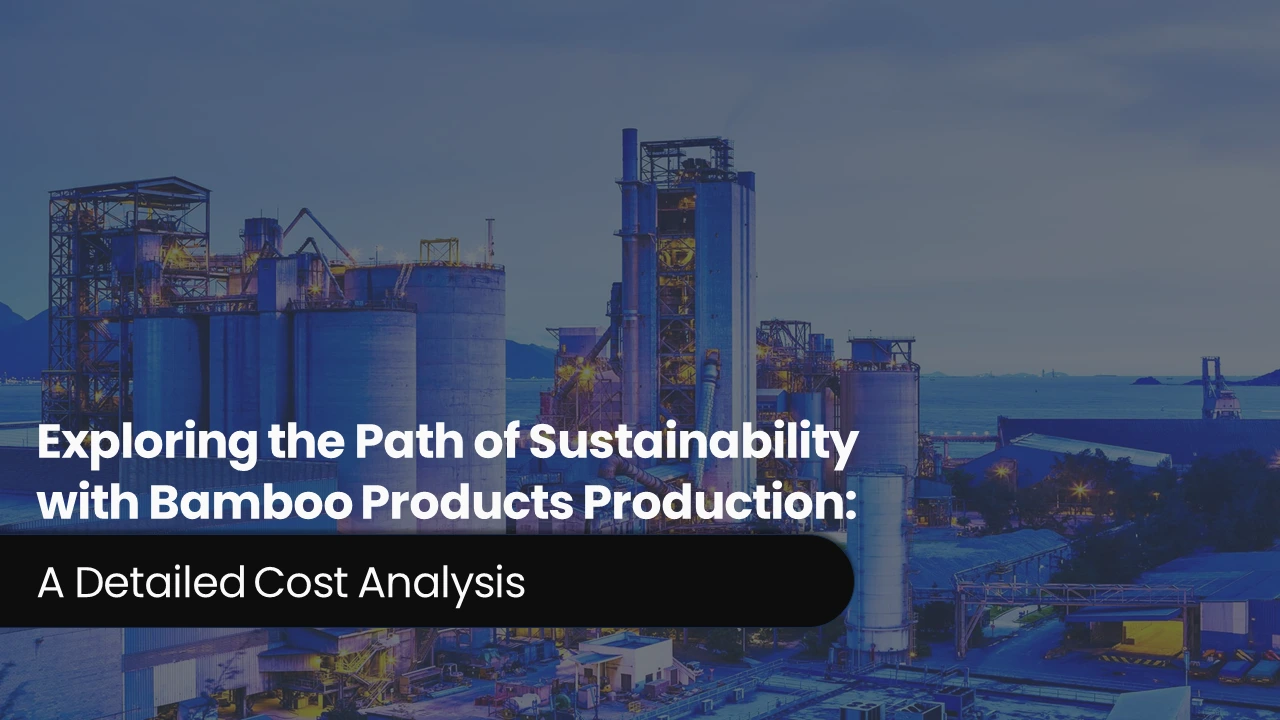
What is Bamboo Products?
Bamboo is one of the sustainable and versatile materials that are being used in several different industries.
Key Applications Across Industries:
Bamboo provides a very environmentally friendly option for food packaging, as it reduces plastic use. At high temperatures, bamboo is burnt to produce bamboo biochar. This is a soil enhancer for soil health and carbon sequestration. Bamboo is also a sustainable building material and is used in the construction industry. Due to its antibacterial properties, bamboo vinegar, which is a byproduct of bamboo charcoal manufacturing, is used in skincare and agriculture.
What the Expert Says: Market Overview & Growth Drivers
According to an IMARC study, the India bamboo products market was valued at INR 2,319.1 Million in 2024, growing at a CAGR of 3.0% from 2019 to 2024. Looking ahead, the market is expected to grow at a CAGR of approximately 6.5% from 2025 to 2033, reaching a projected value of INR 4,046.2 Million by 2033. Growing environmental consciousness and a global trend towards sustainable and eco-friendly materials are driving the market for bamboo goods.
Bamboo is gaining popularity as a replacement for traditional materials like steel, wood, and plastic, given its fast growth rate and renewable characteristics. The increase in demand for bamboo-based products such as furniture, flooring, paper, textiles, and disposable items is largely influenced by the government's initiative of green business policies and a complete ban on single-use plastics. The market is increasing due to the building industry's use of bamboo as reinforcing, panels, and scaffolding. Furthermore, due to its cost-effectiveness, durability, and versatility, bamboo has become the choice for most applications that generate more demand from consumers and firms across the world.
Case Study on Cost Model of Bamboo Products Manufacturing Plant:
Objective
One of our clients has approached us to conduct a feasibility study for establishing a mid to large-scale bamboo products manufacturing plant in Arunachal Pradesh, India.
IMARC Approach: Comprehensive Financial Feasibility
We have developed a comprehensive financial model for the plant's setup and operations. The proposed facility is designed with an annual production capacity of 35 tons of bamboo packaging in food industry, 1,260 tons of bamboo construction materials (panels), 76 tons of biochar, 13 tons of bamboo vinegar, and 265 tons of bamboo fiber and yarn.
Manufacturing Process:
Bamboo Packaging for Food Industry: The manufacturing process of bamboo packaging for the food industry begins with raw material procurement, ensuring high-quality bamboo is sourced. After being sawed or trimmed to the appropriate size, the bamboo is continuously boiled to remove impurities and increase its durability. Using precise processes, the treated bamboo is moulded and sculpted into packaging forms such as wraps, plates, or containers. Testing and quality control make sure the packaging satisfies requirements for durability and food safety. The products are then meticulously packaged and sent to merchants or customers in the food business, with a focus on sustainable and environmentally friendly packaging options.
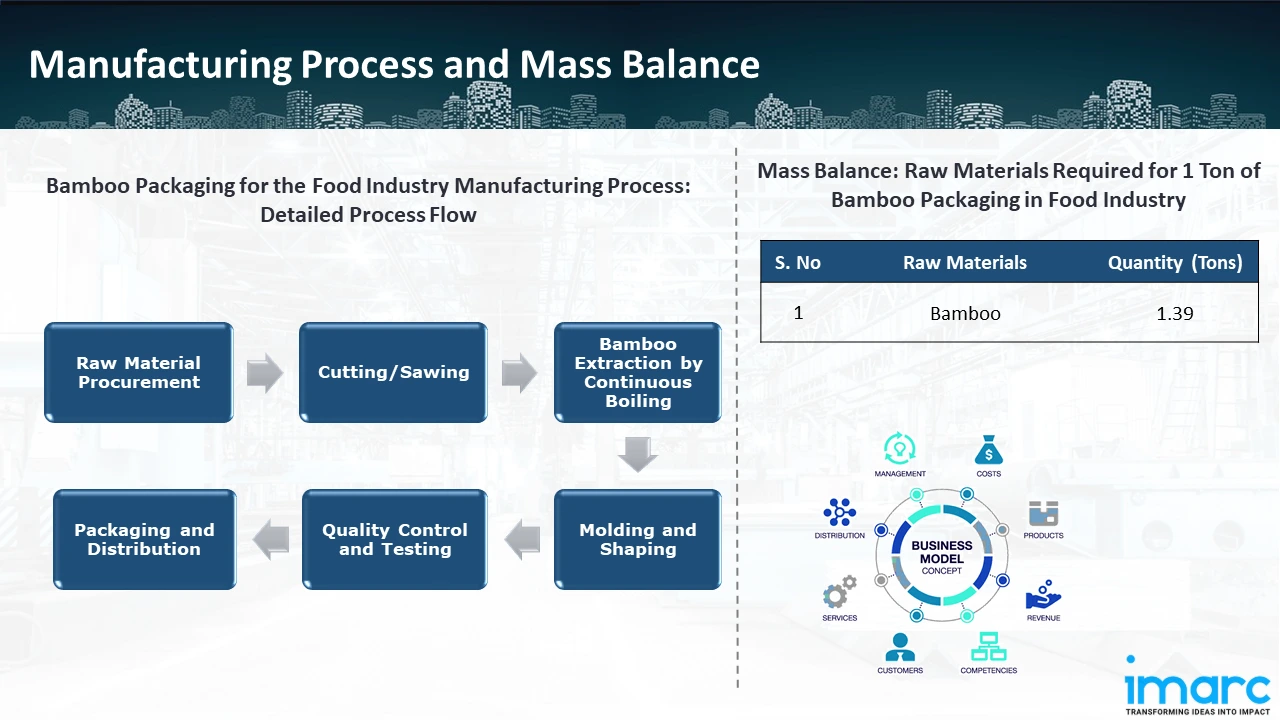
Get a Tailored Feasibility Report for Your Project Request Sample
Bamboo Biochar: The production of bamboo biochar begins with sourcing good quality bamboo and processing it into smaller pieces. These materials are dried in a pre-dryer to remove most of the water content. Dried bamboo is then pyrolyzed in a controlled oxygen environment at high temperatures in a carbonizer, turning bamboo into a material resembling charcoal called biochar. The produced biochar is collected and tested for conformity to quality specifications before packaging and distribution.
Bamboo Vinegar: Bamboo shreds are made and dried initially in a pre-dryer to remove excess moisture. Following drying, it is treated through a carbonizer, wherein a low-oxygen atmosphere bamboo is subjected to pyrolysis. It collects bamboo smoke during this procedure and passes that through a condensing device. After distillation has removed contaminants, premium bamboo vinegar is packaged and sold for several applications.
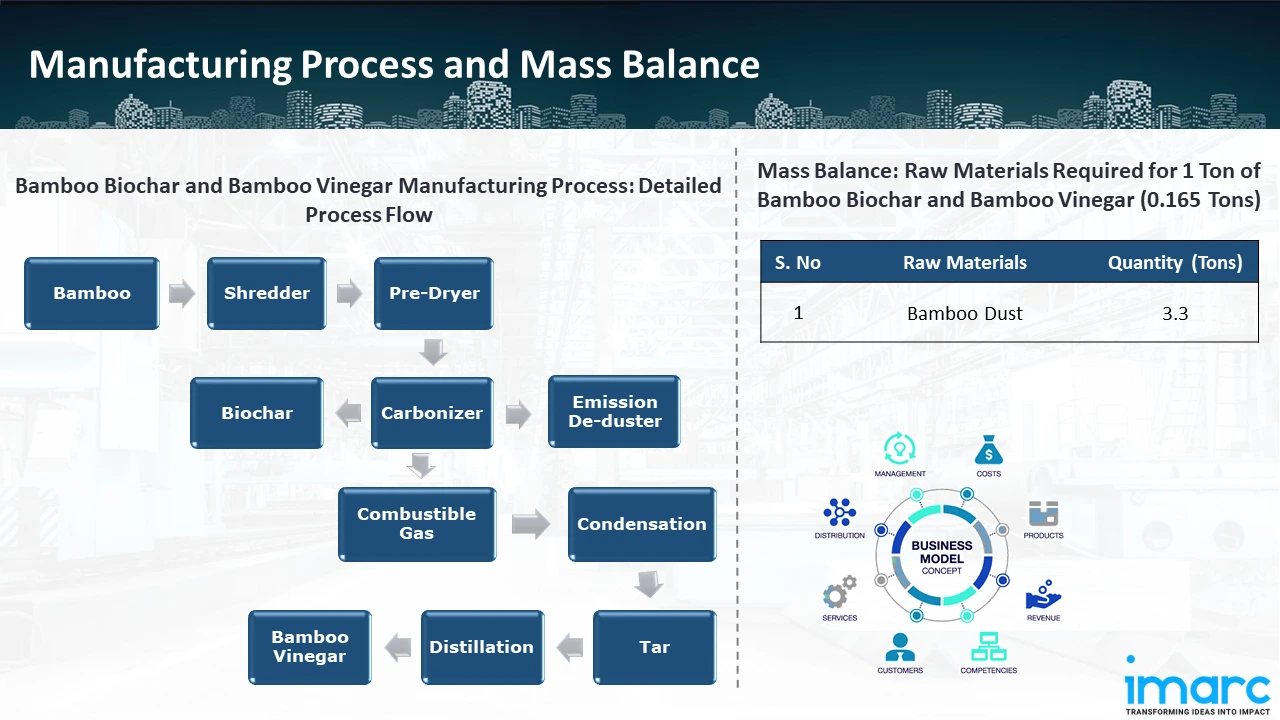
Bamboo Construction Materials (Panels): Harvesting bamboo and cutting the poles into strips is the first step in making bamboo panels. To ensure consistent output, these strips are crushed and processed. After that, they are boiled or carbonised to improve stability, durability, and insect resistance. The strips are then matched for colour consistency and sanded to ensure smoothness after drying. After the strips are bonded together with glue, the panels are heated to create long-lasting structures. After that, the panels are polished, sanded, and coated for both protection and visual appeal. Before packaging and loading for distribution, a last inspection guarantees consistency and quality. High-strength, environmentally friendly panels that are appropriate for a range of construction applications are produced by this procedure.
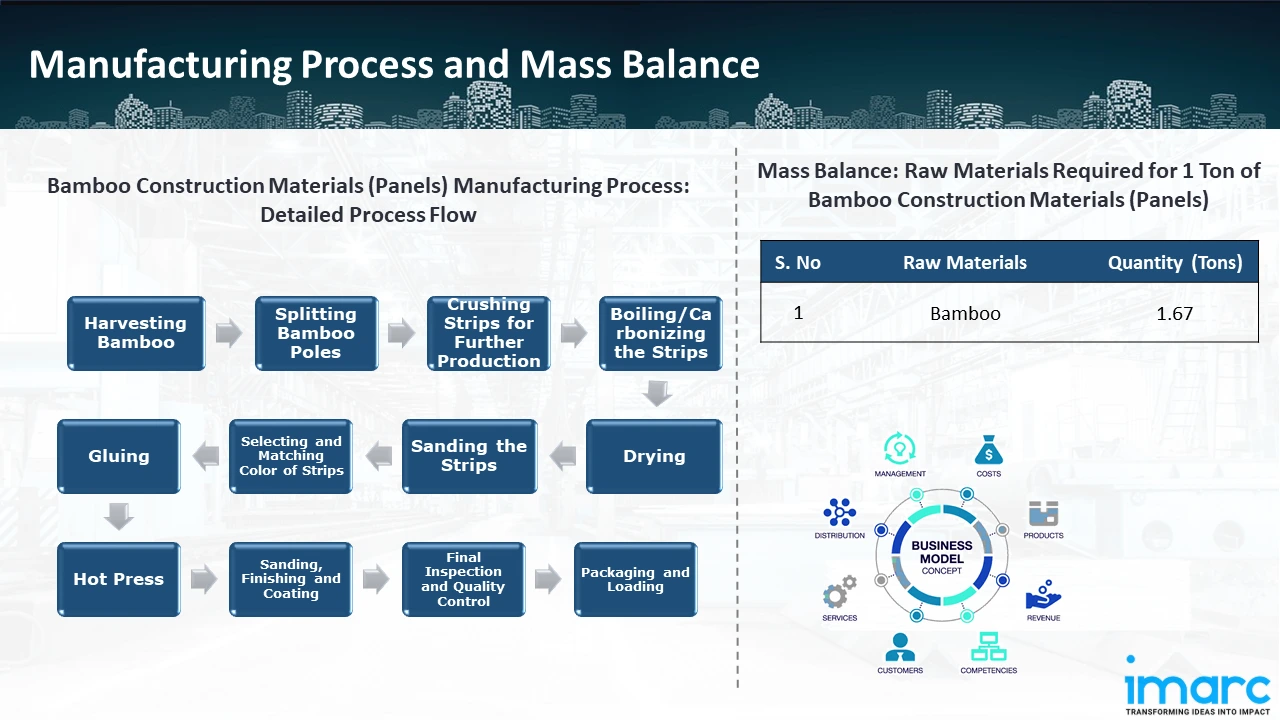
Bamboo Fiber and Yarn: The manufacturing process of bamboo fiber and yarn begins with harvesting and extracting bamboo, which is then boiled to soften the material. To preserve the pulp's quality, NMMO (N-Methylmorpholine N-oxide) is used for extraction, and hydrogen peroxide is then used for stabilisation. To get it ready for additional processing, the pulp is cleaned and dried. After that, it passes through a spinneret to create fine fibres, which are then made more durable by hardening them in an ethanol bath. The fibres are then spun and weaved into yarn, producing a material that can be used in textiles and other applications that is both eco-friendly and multifunctional. This procedure guarantees the creation of premium, sustainable bamboo yarn and fibre.
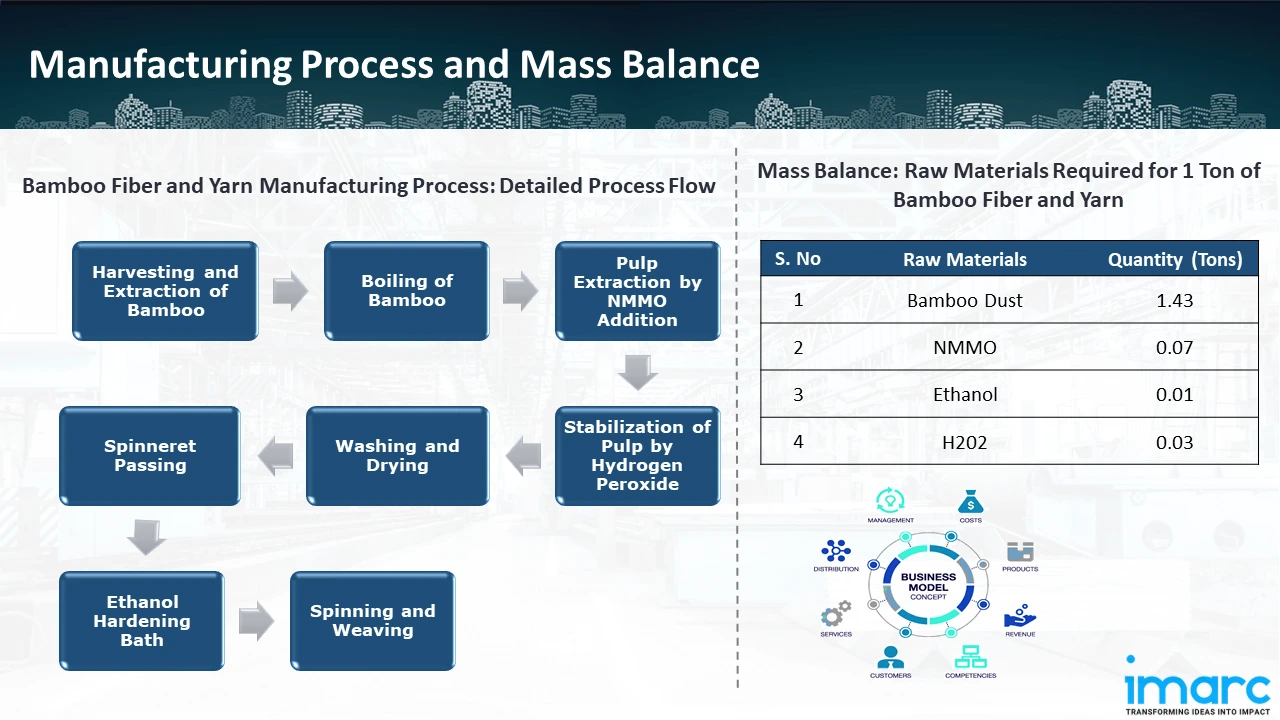
Mass Balance and Raw Material Required: The primary raw materials utilized in the bamboo products manufacturing plant include bamboo, bamboo dust, NMMO, ethanol, and hydrogen peroxide. To produce 1 ton of bamboo packaging for food industry, we require 1.39 tons of bamboo. To produce 1 ton of bamboo biochar and 0.165 of bamboo vinegar, we need 3.3 tons of bamboo dust. Additionally, to produce 1 ton of bamboo construction materials (panels), we require 1.67 tons of bamboo. Finally, to produce 1 ton of fiber and yarn, we require 1.43 tons of bamboo dust, 0.07 tons of NMMO, 0.01 tons of ethanol, and 0.03 tons of hydrogen peroxide.
List of Machinery:
The following equipment was required for the proposed plant:
- Splitting Machine
- Horizontal Carbonizer (Integrated)
- Belt Conveyor
- 4-Sides Planing Machine
- Bamboo Floor and Board Joining Machine 4’ X 8’ (1-Layer)
- Sanding Machine
- Saw Machine
- Carbon Boiler 2.5M (Stainless Steel)
- Dryer
- Multiple Grinding Machine
- Dust Collector
- Stainless Steel Steam Boiling Tank (Outside) 2480x1380x1500mm (Inside) 2400x1200x1400mm
- Automatic Glue Mixing Machine,Feeding & Applying Machine
- Peeling Machine 1.5'
- Rotary Verticle Digestor
- Waste Water Treatment
- Tableware Making Machine
- Tableware Machine Mold
- Automatic Bale Plucker, M4X Storage Box, C-1 Opening Machine, Continuous Feeding System, Metal/sparkdebris two in one Separator
- Chute Feeder
- Carding Machine
- Roving Frame
- Ring Spinning Machine
- Rooftop Solar Panel System (0.5 MW)
Techno-Commercial Parameter:
- Capital Investment (CapEx): Capital expenditure (CapEx) in a manufacturing plant includes various investments essential for its setup and long-term operations. It covers machinery and equipment costs, including procurement, installation, and commissioning. Civil works expenses involve land development, factory construction, and infrastructure setup. Utilities such as power, water supply, and HVAC systems are also significant. Additionally, material handling systems, automation, environmental compliance, and safety measures are key components. Other expenditures include IT infrastructure, security systems, and office essentials, ensuring operational efficiency and business growth.
- Operating Expenditure (OpEx): Operating expenditure is the cost incurred to operate a manufacturing plant effectively. OpEx in a manufacturing plant typically includes the cost of raw materials, utilities, depreciation, taxes, packing cost, transportation cost, and repairs and maintenance. The operating expenses are part of the cost structure of a manufacturing plant and have a significant effect on profitability and efficiency. Effective control of these costs is necessary for maintaining competitiveness and growth.
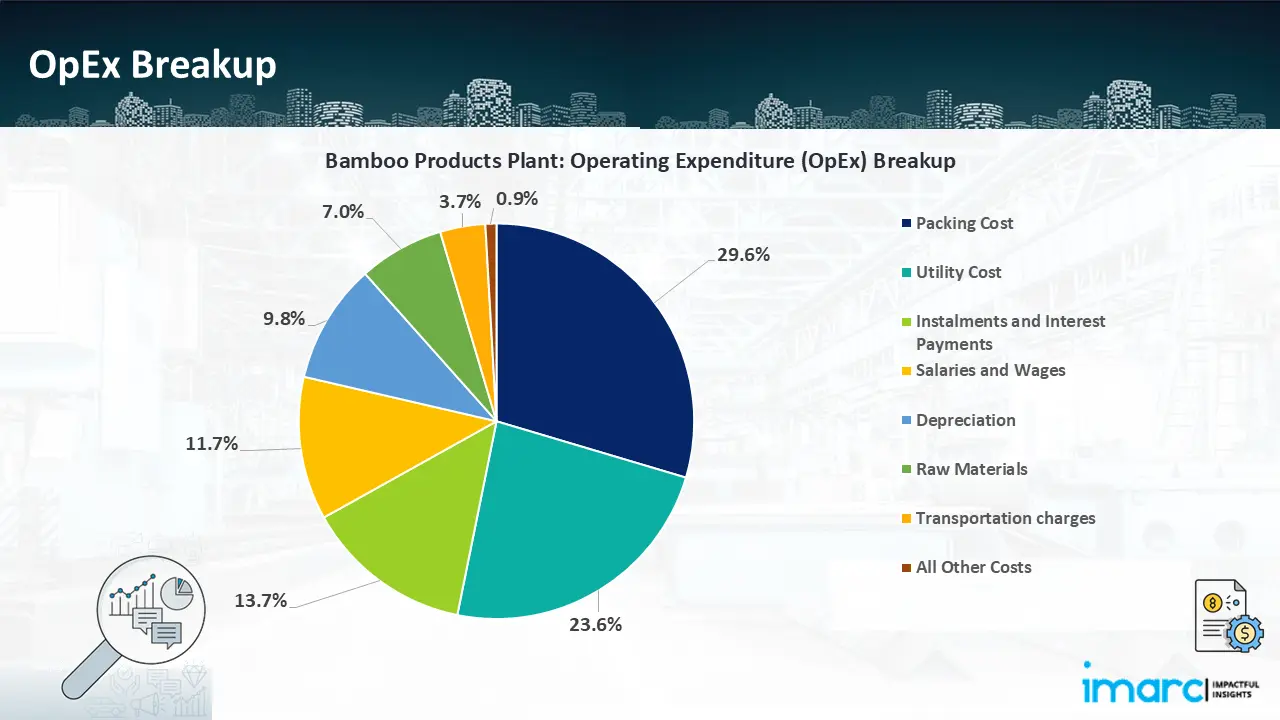
- Profitability Analysis Year on Year Basis: The proposed bamboo products plant, with a processed capacity of 2,148 tons per annum, achieved an impressive revenue of INR 205.09 million in its first year. We assisted our client in developing a detailed cost model, which projects steady growth, with revenue rising throughout the projected period. Gross profit improved from 49.16% to 52.49%, and net profit rise from 25.64% to 32.68%, highlighting strong financial viability and operational efficiency.
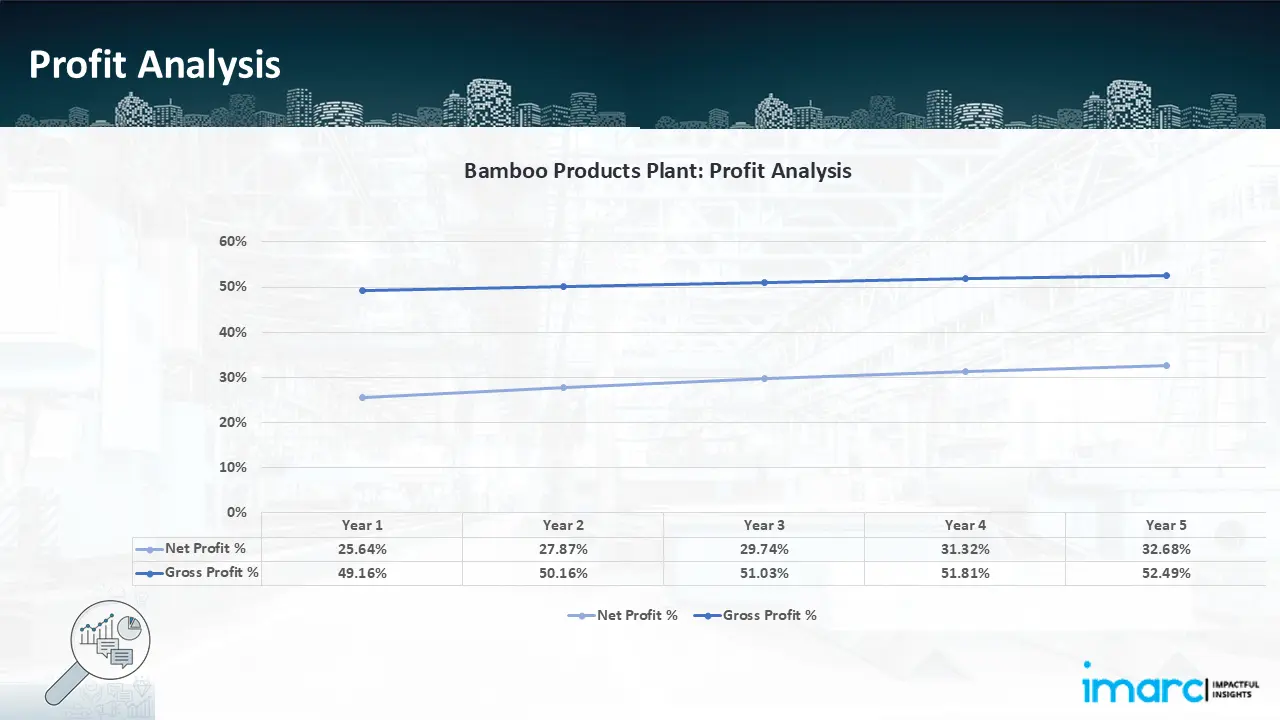
Conclusion & IMARC's Impact:
Our financial model for the bamboo products manufacturing plant was meticulously designed to meet the client’s objectives. It provided a thorough analysis of production costs, including raw materials, manufacturing processes, capital expenditure, and operational expenses. Tailored to the specific requirement of processing 2,148 tons of bamboo products annually, the model highlights key cost drivers and forecasts profitability, considering market trends, inflation, and potential fluctuations in raw material prices. This comprehensive financial model offers the client valuable insights for strategic decision-making, demonstrating our commitment to delivering precise, client-focused solutions that ensure the long-term success of large-scale manufacturing projects.
Latest News and Developments:
- In January 2025, Bonjour has introduced environmentally friendly bamboo socks with a focus on comfort and sustainability. These bamboo-fiber socks have antibacterial, moisture-absorbing, and biodegradable qualities that guarantee their softness and longevity. The program is in line with the increased demand from consumers for eco-friendly fashion solutions.
- In November 2024, angel investors recently invested more than US$ 1.8 Million to the Tacoma, Washington-based firm, which was founded in 2019 under the name Eco-Shelter and is now changing its name to Ocean. Over the years, the National Science Foundation (NSF) has awarded Ocean an extra US$ 1.8 Million. Ocean produces inexpensive, high-performing bamboo building materials.
- In November 2023, China has started a three-year effort to promote bamboo as a sustainable alternative to plastics. The plan calls for the development of an industrial system that includes deep processing, bamboo cultivation, and market expansion to achieve the objective. Enhancing bamboo's ability and efficiency to replace plastic is the aim to contribute to the decrease of plastic pollution.
- In September 2023, the Aditya Birla Group's Birla Cellulose has introduced EcoSoft, a bamboo viscose fibre intended for environmentally friendly textile uses. This innovation focusses on giving textiles a velvety, opulent feel while integrating environmentally sustainable production methods. EcoSoft helps to lessen the textile industry's environmental impact and promotes circularity in fashion.
- In July 2023, Modern Crew has launched a new collection made from bamboo fabric, emphasizing eco-friendliness and comfort. This sustainable range leverages bamboo's natural properties, including softness, breathability, and antibacterial benefits, appealing to environmentally conscious consumers seeking versatile and stylish apparel.
Why Choose IMARC:
IMARC's Financial Model Expertise: Helping Our Clients Explore Industry Economics
IMARC is a global market research company that offers a wide range of services, including market entry and expansion, market entry and opportunity assessment, competitive intelligence and benchmarking, procurement research, pricing and cost research, regulatory approvals and licensing, factory setup, factory auditing, company incorporation, incubation services, recruitment services, marketing and sales.
Brief List of Our Services: Market Entry and Expansion
- Market Entry and Opportunity Assessment
- Competitive Intelligence and Benchmarking
- Procurement Research
- Pricing and Cost Research
- Sourcing
- Distribution Partner Identification
- Contract Manufacturer Identification
- Regulatory Approvals, and Licensing
- Factory Setup
- Factory Auditing
- Company Incorporation
- Incubation Services
- Recruitment Services
- Marketing and Sales
Under our factory setup services, we assist our clients in exploring the feasibility of their plants by providing comprehensive financial modeling. Additionally, we offer end-to-end consultation for setting up a plant in India or abroad. Our financial modeling includes an analysis of capital expenditure (CapEx) required to establish the manufacturing facility, covering costs such as land acquisition, building infrastructure, purchasing high-tech production equipment, and installation. Furthermore, the layout and design of the factory significantly influence operational efficiency, energy consumption, and labor productivity, all of which impact long-term operational expenditure (OpEx). So, every parameter is covered in the analysis.
At IMARC, we leverage our comprehensive market research expertise to support companies in every aspect of their business journey, from market entry and expansion to operational efficiency and innovation. By integrating our factory setup services with our deep knowledge of industry dynamics, we empower our clients to not only establish manufacturing facilities but also strategically position themselves in highly competitive markets. Our financial modeling and end-to-end consultation services ensure that clients can explore the feasibility of their plant setups while also gaining insights into competitors' strategies, technological advancements, and regulatory landscapes. This holistic approach enables our clients to make informed decisions, optimize their operations, and align with sustainable practices, ultimately driving long-term success and growth.
Our Clients
Contact Us
Have a question or need assistance?
Please complete the form with your inquiry or reach out to us at
Phone Number
+91-120-433-0800+1-201-971-6302
+44-753-714-6104











